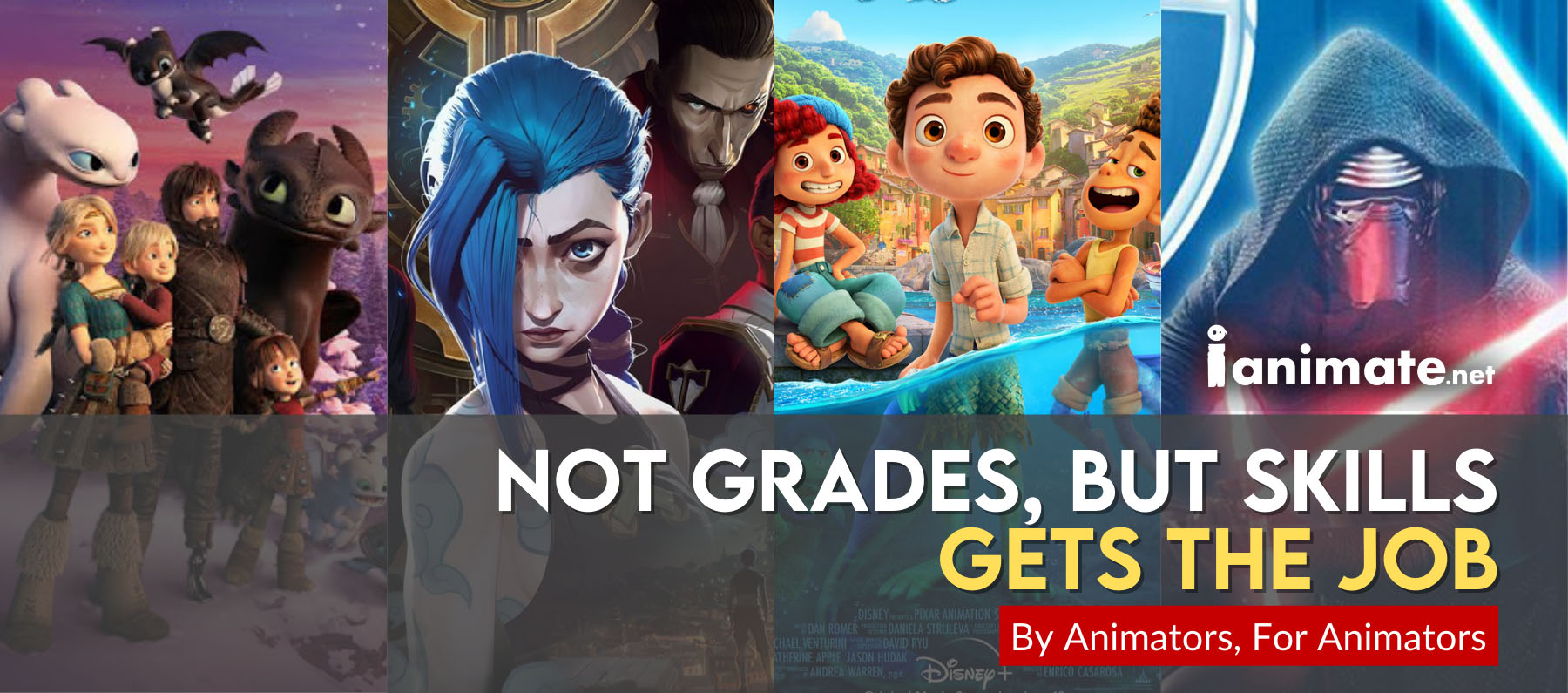How Much Does an Animator Make: Unlocking the Secrets
Article by Richard Arroyo & iAnimate Team
How much does an animator make? Whether you're an aspiring animator or curious about the industry, learn about salaries and what to expect in this profession.

How Much Does an Animator Make?
Have you ever wondered “How much does an animator make?” Whether you're an aspiring animator or simply curious about the industry, understanding the earning potential in this field can be a game-changer. In this article, we'll unlock the secrets behind animator salaries and shed light on what you can expect to earn in this creative profession.
With the animation industry rapidly growing, it's important to stay informed about the financial aspect of being an animator. From entry-level positions to experienced professionals, we'll delve into the various factors that influence earning potential.
But it's not just about the numbers. We'll also explore the different types of animators, the demand for their skills, and the industries that pay top dollar for their services. Plus, we'll uncover some insider tips on how you can maximize your earning potential in the field of animation.
Whether you're considering a career as an animator or simply curious about the industry, this article will provide invaluable insights into the financial side of this dynamic profession. Get ready to unlock the secrets and discover just how much animators earn.
Understanding the Different Types of Animators
Animation is a diverse field with various specializations, each with its earning potential. To understand animator salaries, it's important to familiarize yourself with the different types of animators and the skills they bring to the table.
- Traditional Animators: Traditional animators create hand-drawn or 2D animations. They specialize in creating characters and scenes using pencil and paper or digital tools. While traditional animation may not be as prevalent in today's industry, it still holds a certain charm and is used in films, television shows, and advertisements.
- 3D Animators: 3D animators use computer software to create realistic or stylized animations. They manipulate digital models and create lifelike movements, textures, and lighting effects. 3D animation is widely used in movies, video games, and virtual reality experiences.
- Motion Graphics Animators: Motion graphics animators create animated graphics, typography, and visual effects for various media such as commercials, title sequences, and promotional videos. They combine elements of graphic design and animation to convey information or enhance visual storytelling.
- Visual Effects (VFX) Animators: VFX animators work specifically on creating visual effects for films, television shows, and video games. They use a combination of computer-generated imagery (CGI) and live-action footage to seamlessly integrate animated elements into the final product.
Each type of animator brings a unique skill set to the table, and the demand for these skills can vary depending on industry trends and project requirements. Now, let's explore the factors that influence animator salaries.
Factors that Influence Animator Salaries
When it comes to animator salaries, several factors come into play. Understanding these factors can give you a better idea of what to expect in terms of earnings and help you make informed decisions regarding your career.
- Experience Level: Just like in any profession, experience plays a significant role in determining an animator's salary. Entry-level animators typically earn less than experienced professionals who have spent years honing their skills and building a solid portfolio. As you gain experience and expertise, you can command higher salaries.
- Industry and Job Type: The industry you work in and the type of job you hold can greatly affect your earning potential. Animators who work in high-demand industries such as film, television, video games, and advertising tend to earn higher salaries compared to those in niche or less lucrative sectors. Senior positions or supervisory roles also come with higher pay scales.
- Location: Location can play a significant role in animator salaries. Major cities with a strong animation industry presence, such as Los Angeles, New York, and Vancouver, tend to offer higher salaries due to the higher cost of living and increased demand for talent. On the other hand, smaller cities or regions with fewer animation opportunities may have lower salary ranges.
These factors are just a few examples of what can influence an animator's salary. It's important to keep in mind that salary ranges can vary widely depending on individual circumstances and the specific job market. Now, let's take a closer look at the average salary range for animators.
Average Salary Range for Animators
The average salary range for animators can vary depending on factors such as experience, location, and industry. While it's difficult to pinpoint an exact figure, we can provide a general idea of what you can expect as an animator.
According to the Bureau of Labor Statistics (BLS), the median annual wage for multimedia artists and animators was $99,060 as of 2023. This figure represents the middle point, with half of the animators earning more and half earning less. The lowest 10 percent earned less than $57,090, while the highest 10 percent earned more than $169,580.
It's important to note that these figures are just averages and can vary significantly depending on the factors mentioned earlier. Additionally, freelance animators may have different income structures compared to those working full-time for studios or companies. Let's explore these variations in more detail.
Salary Variations Based on Experience and Location
As mentioned earlier, experience and location are key factors in determining an animator's salary. Let's break down how these factors can influence earning potential.
- Experience: Entry-level animators can expect to earn a lower salary compared to their more experienced counterparts. According to the BLS, the median annual wage for entry-level animators and multimedia artists was around $54,000 as of May 2023. As animators gain experience and move up the career ladder, their earning potential increases significantly. Senior animators or those in supervisory positions can earn well above the average salary range.
- Location: Location plays a crucial role in animator salaries. Major animation hubs such as Los Angeles, New York, and Vancouver tend to have higher salary ranges due to the concentration of animation studios and the demand for talent. For instance, animators working in Los Angeles can earn significantly higher wages compared to those working in smaller cities or regions with fewer animation opportunities.
It's important to consider the cost of living when evaluating salary ranges in different locations. Higher salaries in major cities may be offset by higher living expenses, while lower salaries in smaller areas may provide a more comfortable lifestyle. Now, let's explore additional factors that can impact an animator's earnings.
Additional Factors that Impact Animator Earnings
Apart from experience and location, several other factors can influence an animator's earnings. These factors can vary depending on individual circumstances and the specific job market. Let's take a closer look at some of these additional considerations.
- Skill Set: The specific skills you bring to the table can impact your earning potential. Animators who possess specialized skills such as character rigging, visual effects, or proficiency in specific software packages may be able to command higher salaries due to the demand for these specialized skills.
- Portfolio and Reputation: A strong portfolio showcasing your best work can greatly impact your earning potential as an animator. Employers and clients often look for talented individuals with a proven track record of delivering high-quality work. Building a solid portfolio and establishing a positive reputation within the industry can lead to better job opportunities and higher-paying projects.
- Networking and Connections: Building a strong professional network can open doors to new opportunities and higher-paying projects. Networking with industry professionals, attending conferences and events, and maintaining connections with colleagues can help you stay in the loop regarding job openings and freelance gigs. A strong network can also lead to referrals and recommendations, which can positively impact your earning potential.
Remember, these additional factors are not set in stone, and their influence can vary depending on individual circumstances and the specific job market. However, paying attention to these factors and continuously improving your skills and network can help you maximize your earning potential as an animator. Now, let's explore some tips for increasing your animator income.
Tips for Increasing Animator Income
If you're looking to increase your animator income, consider implementing these tips to boost your earning potential.
- Continuous Learning: The animation industry is constantly evolving, with new techniques and software being introduced regularly. Invest time in continuous learning to stay up-to-date with the latest trends and technologies. Expanding your skill set can make you more marketable and increase your chances of landing higher-paying projects.
- Specialize: Consider specializing in a specific area of animation that is in high demand. By becoming an expert in a particular niche, you can position yourself as a go-to professional for specialized projects and potentially command higher rates.
- Build a Strong Portfolio: Your portfolio is your calling card in the animation industry. Continuously update and improve your portfolio to showcase your best work. A strong portfolio can help you stand out from the competition and attract higher-paying clients or job offers.
- Network: Networking is essential in any industry, and animation is no exception. Attend industry events, join online communities, and connect with other professionals in the field. Building relationships and maintaining connections can open doors to new opportunities and increase your chances of landing higher-paying projects.
- Consider Freelancing: Freelancing can offer flexibility and potentially higher earning potential compared to working full-time for a studio. As a freelancer, you have the freedom to set your rates and choose the projects you want to work on. However, freelancing also comes with its challenges, such as managing your own business and finding clients. It's important to carefully consider the pros and cons before diving into freelancing.
Implementing these tips can boost your animator's income over time. Success in the animation industry demands dedication, continuous improvement, and adaptability to new technologies and trends. iAnimate can help you achieve this success by offering advanced training, industry insights, and hands-on experience with the latest animation tools, ensuring you stay competitive and skilled in your profession.
Resources for Finding Animation Job Opportunities
Finding animation job opportunities can be a daunting task, especially for those new to the industry. However, several resources can help you navigate the job market and find the right opportunities for your skill set. Here are some valuable resources to consider:
- Online Job Boards: Websites like Indeed, Glassdoor, and LinkedIn often feature job postings specifically for animators and multimedia artists. These platforms allow you to search for relevant positions based on location, experience level, and industry.
- Animation Studios and Companies: Many animation studios and companies have dedicated career pages on their websites where they post job openings. Research and bookmark the websites of studios you admire, and regularly check for new job postings.
- Industry Associations and Organizations: Joining industry associations and organizations can provide valuable networking opportunities and access to job boards or job fairs. Examples of such organizations include the Animation Guild, ASIFA-Hollywood, and the Visual Effects Society.
- Freelancing Platforms: If you're interested in freelancing, consider signing up for freelancing platforms such as Upwork, Freelancer, or Fiverr. These platforms connect freelancers with clients seeking animation services and can provide a steady stream of projects.
- Social Media: Follow animation industry professionals and studios on social media platforms like Twitter, Instagram, and LinkedIn. They often share job postings and relevant industry news that can help you stay informed about job opportunities.
By utilizing these resources and actively searching for job opportunities, you can increase your chances of finding relevant animation positions that align with your career goals.
Freelancing vs. Working for a Studio: Pros and Cons
When considering a career in animation, one important decision to make is whether to freelance or work for a studio. Both options have their pros and cons, and it's essential to weigh them carefully to make an informed choice. Let's explore the advantages and disadvantages of each option.
Freelancing:
Pros:
- Flexibility and control over your schedule and projects.
- Potential for higher earning potential compared to working for a studio.
- Ability to work on a variety of projects and expand your skill set.
- Opportunity to build your brand and business.
Cons:
- Uncertainty in terms of project availability and income stability.
- Responsibility for finding clients, negotiating rates, and managing your own business.
- Potential for longer working hours and less work-life balance.
- Lack of employee benefits and job security.
Working for a Studio:
Pros:
- Stability in terms of regular income and employment benefits.
- Opportunities for career growth, mentorship, and learning from experienced professionals.
- Collaboration with a team and exposure to larger projects.
- Access to resources, equipment, and software provided by the studio.
Cons:
- Limited control over projects and creative decisions.
- Potentially lower earning potential compared to freelancing.
- Higher competition for studio positions, especially in desirable locations.
- Less flexibility in terms of schedule and project selection.
Ultimately, the choice between freelancing and working for a studio depends on your personal preferences, career goals, and risk tolerance. Some animators thrive in the freedom and flexibility of freelancing, while others prefer the stability and resources provided by a studio environment. Consider your priorities and long-term goals when making this decision.
Conclusion: Pursuing a Career in Animation and What to Expect in Terms of Earnings
Pursuing a career in animation can be an exciting and fulfilling journey. While the financial aspect is just one piece of the puzzle, understanding animator salaries and the factors that influence earning potential is crucial for making informed decisions.
In this article, we've explored the different types of animators, the factors that influence animator salaries, and the average salary range in the industry. We've also discussed additional factors that impact animator earnings and provided tips for increasing animator income.
Whether you choose to specialize in traditional animation, 3D animation, motion graphics, or visual effects, the animation industry offers a wide range of opportunities for talented individuals. By continuously improving your skills, building a strong portfolio, networking with industry professionals, and exploring job opportunities through various resources, you can maximize your earning potential as an animator.
Remember, success in the animation industry requires dedication, hard work, and a passion for the craft. By unlocking the secrets behind animator salaries and staying informed about industry trends, you can set yourself up for a rewarding career in this dynamic profession.
iAnimate can help you thrive in this competitive industry by providing advanced training, industry insights, and hands-on experience with the latest animation tools. Their courses are designed to keep you ahead of the curve, ensuring you develop the skills and knowledge needed to excel. With iAnimate's support, you can confidently embark on your journey to become a successful animator, armed with the expertise to maximize your earning potential.






